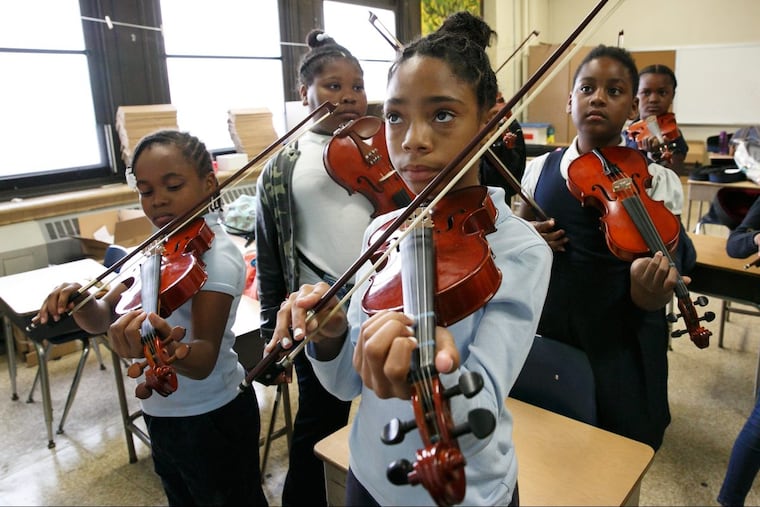Some Philly schools have rich arts programs, and others have none. How do you fix it?
"We still face that narrative of, 'There's no arts in the schools,'" said the Philadelphia schools' head of arts education. "But we're the third-largest arts spender in the city, and we have the largest reach. We still see great opportunities to grow and reach more students."

Saamir Moore holds the violin he plays at Mitchell Elementary in Southwest Philadelphia as if it is the most precious object in the world.
To the fifth grader, it is that and more: a reason to attend and do well in class, and a chief joy in his life.
"Music," said Saamir, 11, "helps me when I'm mad or sad. I love it."
Across the city, children have uneven opportunities to participate in arts and music programs — some schools are rich with them, and others have none. To afford more resources to children such as Saamir, the Philadelphia School District, the Neubauer Family Foundation, and the University of Pennsylvania's Graduate School of Education are releasing an exhaustive analysis of city schools' arts programs Tuesday that shows where they are and how they operate.
The 16-month, multi-organization dive into the state of arts education shows that despite the district's status as among the poorest in the nation, 90 percent of its 220 schools have full-time art or music education, and 60 percent have both. Others have a patchwork — maybe a full-time art or music teacher, plus a part-time instrumental program, or an after-school program run by a community partner.
A few have no arts programs at all — a legacy of high-stakes testing, budget cuts, hiring and scheduling challenges, or other factors, officials said.
The aim is to redesign and amplify arts education in city schools, with more opportunities for students, better training for teachers, and more support for principals, said Frank Machos, executive director of the district's Office of Arts & Academic Enrichment. There's also a push to make it easier for outside organizations to understand the needs of specific schools and partner with them.
The goal is to get instrumental music into every elementary school and to make traditional (drawing, drama, classical music) and modern (game design, hip-hop dancing, filmmaking) elective opportunities available at the secondary level. This year, schools will assess their needs and develop plans for what they'd like over the next five years; schools, district officials, and outside partners will work to make that a reality, they said.
A public, searchable map will allow parents, arts organizations and other interested parties to see where resources — and gaps — are.
"We still face that narrative of, 'There's no arts in the schools,'" said Machos. "But we're the third-largest arts spender in the city, and we have the largest reach. We still see great opportunities to grow and reach more students."
Mitchell has a full-time art teacher; an instrumental music teacher who spends part of his week at the school; and the violin program, which is funded by Wayne Presbyterian Church, a longtime partner of the school's. Principal Stephanie Andrewlevich loves what arts do for the school at 55th and Kingsessing but wishes she had more of it: Fewer than 10 percent of the school's 540 K-8 students have access to music classes.
"The arts allow a child to realize an ability they didn't know they had," said Andrewlevich.
There is no price tag attached to the citywide initiative; a large part of the effort is better harnessing the efforts of over 400 community partners willing to offer Philadelphia kids arts education at low or no cost.
"I don't think this is a budget issue, so much as it is a networking, purposeful planning issue," said Andrewlevich, a third-year principal adept at securing outside help for her school.
The effort included conversations with students, teachers, and principals; a national examination of best practices; and workshops with 50 community arts programs, some of which had never collaborated, said Martin Ihrig, a professor at Penn's Graduate School of Education and at Wharton.
"It was, 'How can we be more entrepreneurial when it comes to helping the kids?'" said Ihrig. "We structured ourselves this way to solve a public problem."
Part of the problem, historically, has been the district's reputation as not always easy to work with or navigate.
"Absent this framework, it's really tough to say, 'I'm an arts organization, how do I support schools?'" said Daniel Berkowitz, chief strategy officer for the Neubauer Family Foundation.
But it's not just about outside providers.
An analysis of the city's instrumental music programs completed by Councilwoman Helen Gym's office earlier this year, for example, found that many city schools that lack such programs are concentrated in high-poverty areas that serve large numbers of minority students.
To help address that deficiency, the district added instrumental music at 14 additional schools this year, Machos said; in fact, the number of arts educators has increased steadily over the past several years, from 390 arts teachers in the 2013-14 school year to 437 this year. His department has also added employees and a renewed focus on equity and access, he said.
"We're seeing where programs are, where there are deficiencies, and we're being more intentional," he said. "Some schools, we need to be more proactive with, and that's one of our priorities going forward."
Machos said the process was driven by a mandate from Superintendent William R. Hite Jr. and his team to get more arts into schools.
"Little kids are intrinsically artistic," Machos said. "It's our job to embrace that and bring it out. We have an opportunity to be a global leader in arts education."